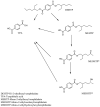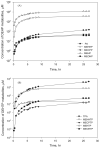Identification of di-2-ethylhexyl terephthalate (DEHTP) metabolites using human liver microsomes for biomonitoring applications
- PMID: 25687528
- PMCID: PMC4556272
- DOI: 10.1016/j.tiv.2015.02.002
Identification of di-2-ethylhexyl terephthalate (DEHTP) metabolites using human liver microsomes for biomonitoring applications
Abstract
Di-2-ethylhexyl terephthalate (DEHTP), a structural isomer of the plasticizer di-2-ethylhexyl phthalate (DEHP), is used in food packaging and medical devices, among other applications, and is a potential replacement for DEHP and other ortho-phthalate plasticizers. Identifying sensitive and specific biomarkers of DEHTP is necessary to assess humans' background exposure to DEHTP. Using mass spectrometry, we investigated the metabolism of DEHTP by human liver microsomes to identify in vitro DEHTP metabolites. We unequivocally identified terephthalic acid (TPA) and mono-2-ethylhydroxyhexyl terephthalate (MEHHTP), using authentic standards, and tentatively identified mono-2-ethylhexyl terephthalate (MEHTP) and two other oxidative metabolites of DEHTP: mono-2-ethyloxohexyl terephthalate (MEOHTP), and mono-2-ethyl-5-carboxypentyl terephthalate (MECPTP) from their mass spectrometry fragmentation patterns. We also evaluated the formation of in vitro metabolites of DEHP. DEHTP and DEHP produced similar metabolites, but their metabolite profiles differed considerably. DEHTP metabolized to form TPA, a metabolite of several terephthalates, as the major in vitro metabolite, followed by MEHTP, MEHHTP, MEOHTP and MECPTP. MEHTP, MEHHTP, MEOHTP and MECPTP, which are specific metabolites of DEHTP, may be suitable biomarkers for assessing exposure to DEHTP. Nonetheless, data on the urinary excretion fraction and temporal stability of these metabolites, among other considerations, are needed to demonstrate their utility as exposure biomarkers.
Keywords: Biomonitoring; DEHTP; Di-2-ethylhexyl terephthalate; Environmental exposure; Oxidative metabolites.
Published by Elsevier Ltd.
Figures





Similar articles
-
Exposure to di-2-ethylhexyl terephthalate in a convenience sample of U.S. adults from 2000 to 2016.Arch Toxicol. 2017 Oct;91(10):3287-3291. doi: 10.1007/s00204-017-1956-3. Epub 2017 Mar 17. Arch Toxicol. 2017. PMID: 28314884 Free PMC article.
-
Exposure to di-2-ethylhexyl terephthalate in the U.S. general population from the 2015-2016 National Health and Nutrition Examination Survey.Environ Int. 2019 Feb;123:141-147. doi: 10.1016/j.envint.2018.11.041. Epub 2018 Dec 4. Environ Int. 2019. PMID: 30529838 Free PMC article.
-
In vitro metabolites of di-2-ethylhexyl adipate (DEHA) as biomarkers of exposure in human biomonitoring applications.Chem Res Toxicol. 2013 Oct 21;26(10):1498-502. doi: 10.1021/tx400215z. Epub 2013 Sep 24. Chem Res Toxicol. 2013. PMID: 24016063 Free PMC article.
-
Di(2-ethylhexyl)phthalate (DEHP): human metabolism and internal exposure-- an update and latest results.Int J Androl. 2006 Feb;29(1):155-65; discussion 181-5. doi: 10.1111/j.1365-2605.2005.00607.x. Int J Androl. 2006. PMID: 16466535 Review.
-
Di (2-ethyl hexyl) phthalate and its metabolite-induced metabolic syndrome: a review of molecular mechanisms.Drug Chem Toxicol. 2025 Mar;48(2):325-343. doi: 10.1080/01480545.2024.2405830. Epub 2024 Sep 25. Drug Chem Toxicol. 2025. PMID: 39322993 Review.
Cited by
-
Maternal urinary phthalate metabolites are associated with lipidomic signatures among pregnant women in Puerto Rico.J Expo Sci Environ Epidemiol. 2022 May;32(3):384-391. doi: 10.1038/s41370-022-00410-3. Epub 2022 Jan 24. J Expo Sci Environ Epidemiol. 2022. PMID: 35075242 Free PMC article.
-
Characterizing the Contribution of Indoor Residential Phthalate and Phthalate Alternative Dust Concentrations to Internal Dose in the US General Population: An Updated Systematic Review and Meta-Analysis.Int J Environ Res Public Health. 2023 Aug 17;20(16):6589. doi: 10.3390/ijerph20166589. Int J Environ Res Public Health. 2023. PMID: 37623174 Free PMC article.
-
Identification of potential biomarkers of exposure to diundecyl phthalate.Environ Res. 2016 Jul;148:137-143. doi: 10.1016/j.envres.2016.03.037. Epub 2016 Apr 2. Environ Res. 2016. PMID: 27045772 Free PMC article.
-
Development, testing, parameterisation, and calibration of a human PBPK model for the plasticiser, di-(2-ethylhexyl) terephthalate (DEHTP) using in silico, in vitro and human biomonitoring data.Front Pharmacol. 2023 Feb 20;14:1140852. doi: 10.3389/fphar.2023.1140852. eCollection 2023. Front Pharmacol. 2023. PMID: 36891271 Free PMC article.
-
Exposure to di-2-ethylhexyl terephthalate in a convenience sample of U.S. adults from 2000 to 2016.Arch Toxicol. 2017 Oct;91(10):3287-3291. doi: 10.1007/s00204-017-1956-3. Epub 2017 Mar 17. Arch Toxicol. 2017. PMID: 28314884 Free PMC article.
References
-
- Barber ED. Generic toxicology testing of di(2-ethylhexyl) terephthalate. Environ. Mol. Mutagen. 1994;23:228–233. - PubMed
-
- Barber ED, Topping DC. Subchronic 90-day oral toxicology of di(2-ethylhexyl) terephthalate in the rat. Food Chem. Toxicol. 1995;33:971–978. - PubMed
-
- Barber ED, Fox JA, Giordano CJ. Hydrolysis, absorption and metabolism of di(2-ethylhexyl) terephthalate in the rat. Xenobiotica. 1994;24:441–450. - PubMed
-
- Eastman Chemical Company Eastman 168™ Non-Phthalate Plasticizer Receives Additional U.S. FDA Food Contact Clearance. 2011 < http://www.eastman.com/Company/News_Center/2011/Pages/Eastman168_Non_Pht...>.
-
- European Food Safety Authority Opinion of the Scientific Panel on Food Additives, Flavourings, Processing Aids and Materials in Contact with Food (AFC) on a Request Related to a 18th List of Substances for Food Contact Materials. 2008 < http://www.efsa.europa.eu/en/scdocs/doc/628.pdf>. - PMC - PubMed
Publication types
MeSH terms
Substances
Grants and funding
LinkOut - more resources
Full Text Sources
Other Literature Sources

